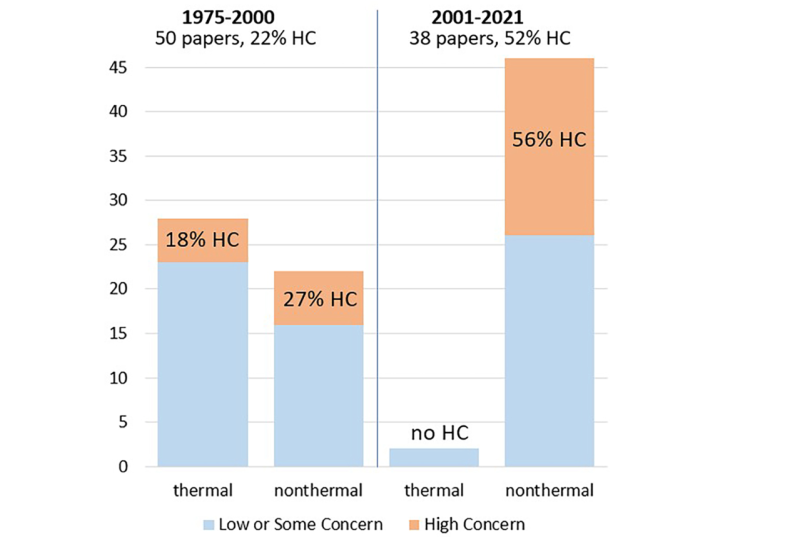
The landscape of non-ionizing radiation (NIR) research has undergone significant transformations over the past few decades. Initially centered on the thermal effects of radiation—those causing direct heat damage to tissues—research focus has notably shifted towards exploring nonthermal effects, which occur without significant heat generation but may still pose health risks. This article delves into the evolution of NIR research, highlighting changes in study focus, methodology, and the implications of these shifts for public health and regulatory policies.
Introduction: The Paradigm Shift in NIR Research
Non-ionizing radiation, encompassing electromagnetic fields from microwaves to radio frequencies, is a constant presence in modern life, emitted by everything from cellular phones to hybrid vehicles. Understanding the health implications of NIR exposure is crucial, as public and scientific debates evolve and technology further integrates into daily life.
Historical Overview of NIR Studies
Early Focus on Thermal Effects
The initial research into NIR was predominantly concerned with its thermal effects, which are immediate and measurable, such as tissue heating seen with high exposure levels used in medical therapies or industrial applications.
Shift to Nonthermal Effects Research
By the turn of the century, the focus began to shift towards understanding the nonthermal effects of NIR. These effects include potential cellular damage and other health impacts that might occur at lower levels of exposure, which do not cause noticeable heating but could lead to long-term health issues.
Analysis of Research Trends Over Decades
Distribution of Research Papers Over Time
From 1975 to 2000, a majority of NIR research focused on thermal effects, as evidenced by the 50 papers published during this period. However, from 2001 to 2021, there was a noticeable shift with 38 papers focusing primarily on nonthermal effects.
Risk of Bias in NIR Studies
Interestingly, the risk of bias (RoB) in these studies has seen a significant shift. In earlier studies (1975-2000), only 22% were rated as High Concern for RoB. In contrast, from 2001 to 2021, this percentage more than doubled to 52%, reflecting possibly a growing scrutiny or evolving methodologies in newer research.
Thermal vs. Nonthermal Focus
Initially, most studies were thermal in nature, but recent decades have seen a predominance of nonthermal studies, which now constitute the majority of research. Furthermore, newer nonthermal studies are more likely to be rated as High Concern compared to older thermal studies, suggesting a change in either the research landscape or in the criteria for evaluating research quality.
Implications for Public Health and Policy
Regulatory Challenges
The shift from thermal to nonthermal research poses significant challenges for regulators. Existing guidelines primarily address thermal effects, and the increase in studies showing potential nonthermal risks necessitates a reevaluation of these guidelines.
Public Perception and Health Concerns
The public’s growing awareness of nonthermal effects, coupled with the increased scrutiny of these studies, affects consumer behavior and public health recommendations. As nonthermal NIR research continues to reveal more about potential risks, public health policies must adapt to these findings.
Future Directions in NIR Research
Need for Enhanced Methodological Rigor
The high percentage of newer studies rated as High Concern for bias underscores the need for more rigorous research methodologies. Enhancing study designs and analysis techniques is essential for reducing bias and improving the reliability of research findings.
Integrating Nonthermal Effects into Safety Standards
As nonthermal effects become a focal point of NIR research, integrating these findings into safety standards and public health guidelines is crucial. This integration will help ensure that NIR regulations are based on the most current and comprehensive scientific understanding.
Conclusion: A Call for Comprehensive Research and Updated Regulations
The evolution of NIR research from thermal to nonthermal studies highlights the complexity of understanding and regulating NIR exposure. As technology advances, so too must our scientific approaches and regulatory frameworks. It is imperative that ongoing research addresses the methodological concerns highlighted in recent studies and that regulatory bodies update their guidelines to reflect the latest scientific insights into both thermal and nonthermal effects of NIR.
FAQs
Q1: What is non-ionizing radiation? Non-ionizing radiation refers to electromagnetic radiation that does not carry enough energy to ionize atoms or molecules. It includes radio waves, microwaves, infrared, visible light, and ultraviolet light that does not reach the ionizing threshold.
Q2: What are thermal effects of NIR? Thermal effects of NIR involve the heating of tissue, which can lead to burns and other heat-related damage at high exposure levels.
Q3: Why are nonthermal effects significant? Nonthermal effects of NIR can include biological changes at cellular and molecular levels that do not involve heating but may still pose health risks, such as altered cell growth, DNA damage, and potentially, long-term effects like cancer.
Q4: How have NIR studies evolved over time? NIR studies have evolved from primarily focusing on the clear, measurable thermal effects to exploring the more subtle and less understood nonthermal effects, reflecting both advancements in technology and growing health concerns.